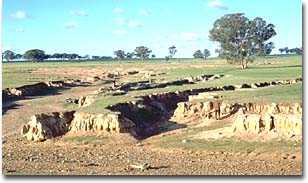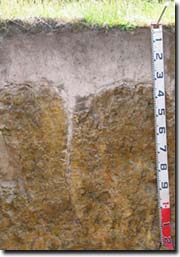Victorian State Soil Contender - Mottled Brown Sodosol

Back to: Contenders for State Soil
Why should the Mottled Brown Sodosol be Victoria’s State Soil?
- Victoria has a greater proportion of Sodosols than any other State of Australia.
- It is unlikely that other Australian states will choose a Sodosol as their State soil.
- Mottled Brown Sodosols are widespread across Victoria, predominantly in the zone of 450 mm to 800 mm rainfall. The soil type in various forms can be found north and south of the Divide, and occurs on a range of parent materials (lithology/geology).
- These soils have traditionally supported grazing enterprises, particularly sheep and lamb production - icons of Australian rural life. They also occur in many of the goldmining areas in the ‘Golden Triangle’ of Victoria and most miners would have had to dig through them on their way to gold bearing sediments.
- These soils represent the oldness of Australian soils and the management and perseverance is required to make a living off them, not like your upstart boutique soil such as a Ferrosol!
- Brown Sodosols are not "nice" soils. They are difficult to manage as they have hard, dense subsoils that are dispersive. The range of soil water content which is conducive to root growth is severely limited due to poor aeration at the wet end and high soil strength at the dry end. Also, these soils are often associated with some of the more extreme forms of tunnel and gully erosion in Victoria.

Land degradation is a major issue associated with Brown Sododols in Victoria
Key features of Mottled Brown Sodosol
Sodosols are texture contrast soils that have lighter textured hardsetting surface horizons (e.g. sandy loam or clay loam) overlying more clayey subsoil (B) horizons. The subsoil horizons are sodic and often dispersive. They are usually coarsely structured, and prismatic and/or columnar peds are common. These characteristics generally restrict root and water movement into the subsoil.
- The subsoils can be dominantly brown to yellow and typically have mixed mottling of yellow, grey, brown or red. The mottled nature of the soil alludes to the variable and restrictive drainage conditions. The mottled subsoil may have relict features; the type of mottling reflecting past or current drainage conditions
- They generally have a bleached subsurface (A2) horizon that abruptly overlies the mottled (most neutral to alkaline) subsoil. This horizon has been leached of most of its nutrients and is often waterlogged as water builds up on top of the dispersive subsoil after heavy rains. These soils have been formerly known as yellow duplex (or Dy) soils using the former Northcote soil classification key.
- Care is required for managing the physical and chemical (nutrient) restrictions for sustainable land use without exacerbating the potential for sheet, rill and gully erosion. Gully and tunnel erosion can be prevalent on these soils in sloping country.
- Maintaining vegetative cover and encouraging organic matter build up are very important for both production and landscape protection with these soils. Organic matter is important for fertility and aggregation on surface soils.
Typical soil profile
|  Brown Sodosol near Fernbank in West Gippsland | ||||||||||||||||||
Brown Sodosol near Heyfield in West Gippsland


